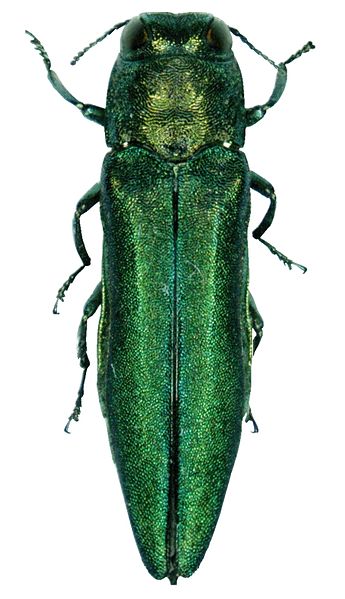Emerald Ash Borer
Taxonomy
Arthropoda » Hexapoda » Insecta » Coleoptera » Polyphaga » Buprestidae » Agrilus » Emerald Ash Borer
Physical Description
Once this beetle reaches adulthood, it posses a metallic green color and is normally close to the size range of being ½” long and ?” wide. The larvae on the other hand, or also known as flatheaded borers, acquire a pale color, elongated body, and flat spot behind the head, hence the nickname.

Source: Pennsylvania Department of Conservation and Natural Resources - Forestry , Bugwood.org
Location
They originated from eastern Russia, Northern China, Korea, and Japan. They have now taken up residency in at least half of the 50 United States. It has only been found in ash trees of the Fraxinus species. Ash trees of Sorbus species, also known as Mountain-ash trees, are not affected by the EAB.
Prey & Predators
They don’t have much working against them besides non-native wasps purposely that are known to suppress the overpopulating beetle and also native woodpeckers that may slow down their fast spreading. The beetle itself preys on the healthy ash trees and consequently has resulted in tens of millions of dying and dead ash trees in less than 15 years of their discovered existence in the U.S.
Harmful to Humans?
Directly, no there has never been many stated incidents in which someone has been stung or bitten by these beetles. Indirectly, most anyone who knows anything about this insect would tell you these beetles are horrible news for the woodlands. After larvae have been planted into an ash tree, it only takes 3-4 years to completely kill the tree. For this reason, many people call the Ash Borer a pest.Reproduction
The EAB typically have an year life expectancy. After these fully grown beetles emerge from the ash trees around spring or summer (depending on location), they will feed on ash leaves for about a week and then mate. A few days after mating, the female will lay several dozen eggs within the next month before her life cycle comes to an end.
Other Names
Agrilus planipennis

